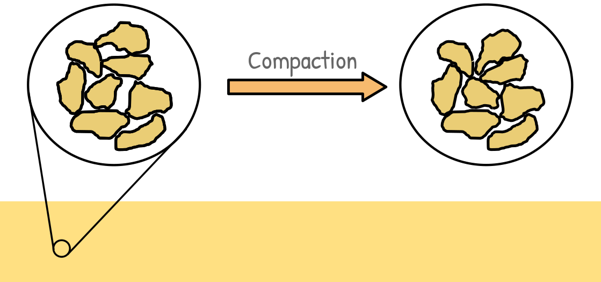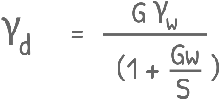Before constructing any structure on the soil, we make the base stable and strong so that it does not settle in large amounts with time. This process of making the soil base solid before the construction of structure is called compaction.
In the process of compaction mechanical energy is applied to the soil so that soil grains rearrange to occupy a denser configuration. This way soil’s density is increased and soil becomes stronger. By strong we mean it has higher shear strength and bearing capacity.

We have discussed all these in a little more detail in our earlier post.
Compaction is usually done with heavy machinery and equipments.

With time we have learned that if we add little water to the soil and then try compacting it, it gets better compacted. Because water acts as lubricating agent and when the load is applied to the soil, it helps soil particles move more easily and helps soil achieve denser configuration.
Compaction is measured by the dry density of soil. Higher the dry density, higher is the compaction.

American civil engineer and soil scientist R. R. Proctor established a relationship between water content in soil and density of soil. He found through his experiments that the dry density of a soil for a given compactive effort depends on the amount of water the soil contains during soil compaction.
He devised a laboratory test that is called Standard Proctor Test or Proctor Compaction Test in his honour. In this test specified amount of compactive effort is applied to a constant volume of soil mass.
We have also discussed Standard Proctor Test in detail in our previous post.
It was observed that Standard Proctor Test is better suited for smaller projects like construction of small building, garden pathway, small retaining walls etc where loads on the soil are not substantial.
But for projects that need heavy compaction of soil such as construction of highways, dams etc, the Standard Proctor Test does not represent the true compaction characteristics.
For such conditions the Standard Proctor Test has been updated into the Modified Proctor Test.
Modified Proctor Test
The Modified Proctor compaction test is a laboratory method used to determine the Optimum Moisture content at which the soil achieves its Maximum Dry Density.
In this test a constant volume of soil mass is compacted using a rammer just like we did in Standard Proctor Test but rammer used in Modified Test is heavier compared to that of the Standard Proctor Test.
The test was standardised by American Association of State Highway officials and was also known as Modified AASHO Compaction Test.
But the AASHO has become AASHTO (American Association of State Highway and Transportation Official) and the Test is now referred to as the Modified AASHTO Compaction Test or AASHTO T 180 test method.
In Modified Proctor Test the mould used is the same as in Standard Proctor Test. It has internal diameter of 4 inches (101.6 mm) and an effective height of 4.584 inches (116.4 mm). Its standard volume is 1/30 cubic foot 944 cubic centimetres (cm³). It also has a detachable base plate and a removable collar of 2 inches height at its top.

The rammer used in Modified Proctor Test is heavier and has a greater drop than that in the Standard Proctor Test. Its weight is 10 pounds (4.535 KG) and the free drop is 18 inches (457.2 mm).

In this test the soil sample collected from the field is pulverised and passed through 20 mm sieve. Then after adding a little water to it, it is filled in the mould in five equal layers. Each layer is compacted by 25 blows of rammer.
The compactive energy imparted to the soil in the Modified Proctor Test is about 4.5 times that in the Standard Proctor Test. Thus much heavier compaction is attained in the Modified Proctor Test.
The procedure of determining the maximum dry unit weight and respective water content is same as the Standard Proctor Test. We take weight of the empty mould then with the compacted soil in it. Difference of weights will give us the weight of compacted soil only.

By this we can calculate the Bulk Unit weight of the soil as weight of compacted soil divided by volume of the mould.

We take a small representative sample from bottom, middle and top of the mould and determine the water content of the compacted soil by any of the water determination methods.
Then we calculate Dry unit weight of the compacted soil by a known relationship.

We repeat the experiment few times by increasing water content every time and obtain respective Dry Unit Weights. We plot our obtained data in a curve which is known as Compaction Curve. The water content at which the soil attains its Maximum Dry Unit Weight or Maximum Dry Density is called Optimum Moisture Content.

Notable thing is, compaction curve for Modified Proctor Test is higher and to the left of that obtained from a Standard Proctor Test for the same soil. The heavier compaction increases the maximum dry density but decreases the optimum water content. The percentage increase of dry density is between 3 to 18 % for most soils.

In the curve we can see that at Optimum Moisture Content soil has achieved Maximum Dry Unit weight or Maximum Dry Density. However, it’s important to note that even at this water content, some voids remain within the soil. In fact, no amount of compaction actually removes all the voids from the soil.
But lets remove all the air voids from the soil theoretically by compacting the soil even more to loose all of its air voids. Hence, we can obtain a theoretical maximum value of dry unit weight a soil can achieve at this water content. As we did not increase the water content but we removed all the air voids, the soil becomes completely saturated and the Degree of Saturation is 100%.
in our previous post of Standard Proctor Test we established the equation for Theoretical Maximum Dry Unit Weight as this.

this is a pre-established equation derivation of which can be found in our earlier post.
We are also aware with this relationship
![]()
and derivation of the same can also be found in that post
from this equation we can write it to find void ratio like this.

and by substituting it in this equation Yd can be written as this.

Using this equation we can calculate Theoretical Maximum Dry Unit Weight of soil for any value of water content. We draw the line indicating the theoretical Maximum Dry Unit Weight along with the compaction curve. It is known as Zero Air Void Line or 100% Saturation Line. We must keep in mind that this curve or line representing 100% saturation is a theoretical limit and is never reached in practice.

It may also be noted that the maximum dry density attained even in the Modified Proctor Test is lower than the theoretical maximum dry density indicated by the zero air-void line.
The purpose of the Modified Proctor Test is same as Standard Proctor Test, that is to find out the Optimum Moisture Content at which soil achieves its Maximum Dry Density. But Modified Proctor Test is used where heavier compaction is needed. Then in the field our goal is to achieve soil density as close as possible to the Maximum Dry Density obtained via laboratory test.
Heavy Compaction Test
In India the Indian Standard recommends a test for heavier compaction that is equivalent of the Modified Proctor Test and it is called the Heavy Compaction Test. There are only minor modifications to the test.
In Heavy Compaction Test the mould is of 100 mm diameter, 127.3 mm height and 1000 ml capacity. The weight of rammer is 4.9 kg and free drop is 450 mm. Also the soil is compacted in 5 layers and each layer is tamped 25 times.

The Standard Proctor Test and Modified Proctor Test are fundamental tools in geotechnical engineering and construction. It provides essential data for achieving proper soil compaction, ensuring the stability and performance of infrastructure projects. The Maximum Dry Density and Optimum Moisture Content values obtained from the test help engineers make informed decisions about soil selection, compaction methods, and structural design.






